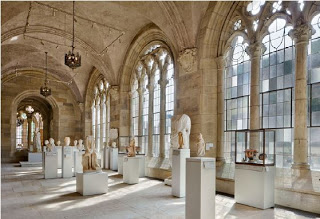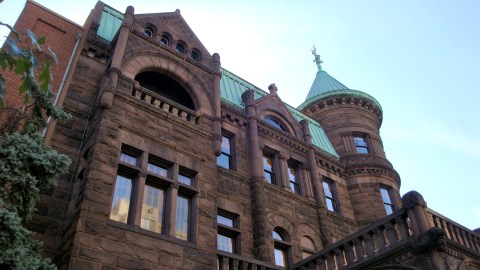
We’ve featured a series of posts on this blog that explore the Campus Art Museums in the 21st Centuryreport issued last year by the Cultural Policy Center at the University of Chicago. Looking back, I realize that we have heard from directors, staff, educators—but not from students. This week’s guest blog rounds out our commentary with a post from Zoe Mercer-Golden, a senior at Yale College who has spent the last three years teaching in the Yale University Art Gallery.
In the past few weeks, I’ve been interviewing students in Yale’s junior class for membership in a student social society that I will soon age out of. Each interviewee is asked a few questions, one of which is: If you had a free afternoon, what would you do with it?
 |
| Ancient Art Sculpture Hall, Yale University Art Gallery |
A disproportionate number of the responses we received this year had to do with the Yale University Art Gallery, which reopened in December to rave local and national reviews. Students on Yale’s campus know that they should be going to the museum—after all, The New York Times told them they should—but many of my classmates have yet to set foot in a museum that cost $135 million dollars and took more than a decade to improve.
Moreover, many of the students I interviewed knew little or nothing about the art gallery’s history or extraordinary collection of objects. Unaware that I work in the gallery’s education department and have given more welcome tours than I can count, interviewees happily told me things about the gallery that aren’t true.
As I listened to their glib answers, I felt torn: happy that they wanted to visit the art gallery, but concerned as to why they hadn’t, and even more concerned about their misconceptions. Their excuses for not visiting included busyness, school work and activities, but the museum is open for many hours a day, six days a week, and is totally free. Surely they could have found a half-hour somewhere in their busy lives to stop by? Going to a museum seemed to rank somewhere towards the bottom on a long list of priorities topped by napping—a sad state of affairs.
These students’ responses are symbolic of the larger problems associated with integrating university art museums into mainstream campus culture—a problem that exists not only at Yale, but also on campuses around the country. Thanks the generous support of alumni and donors, university art museums often have world-class collections of objects that are beautifully preserved and thoroughly studied because of their proximity to cutting-edge technology and innovative scholarship. Yet students rarely make use of these collections unless formally taken to a museum for class or required to visit in order to complete an assignment. The few that go willingly and often are usually, like myself, majoring in a field directly tied to museums (art history, anthropology, archaeology, classics) or are student employees.
Over the past three years, I’ve watched my mentors and teachers at the gallery struggle to bring students into the building: do we extend hours? Give specialized tours? Host free events? Reach out through teachers, deans, dorms? How do we balance being a museum for the local community and the world with being a museum for our campus and students, our chief constituents? Is it enough that we bring students in for classes—or should we re-frame ourselves as a great hang-out spot, a place for conversation, dates and free afternoons?
Right now the Yale University Art Gallery is actively pursuing instructors and administrators, while largely trusting that students will discover the gallery in their own time. Thus far, the strategy has had only moderate success: Few students I’ve talked to are even aware that the gallery offers resources above and beyond its collection. They don’t know that the museum staff is full of many of the best teachers and most thoughtful bosses at Yale; every curatorial department is bursting with research materials, much unpublished, for assignments; staff will drive students to off-site storage to look at many objects; lectures and events are occurring all the time at the art gallery, and students are welcome at almost every one.
Once again I feel frustrated, because I have made use of all the resources listed above, and they have immeasurably improved my time at Yale. The art gallery is my community, my refuge, my intellectual home. But relatively few students can say the same.
This problematic reality may be the gallery’s fault, for hoping students will find their way in on their own, or it may be a fundamental problem with the way that students see art and museums—as a nice diversion but not an essential part of their lives and educations. I hope that the newly re-opened spaces at Yale will signal a shift in the way that students on our campus view and interact with art, and that the art gallery will be as much a home for other students as it has been for me. But I worry about a future in which the art gallery continues to be an activity for only (non-existent) free afternoons, instead of an essential part of a liberal arts education and a quintessential part of the Yale experience.
I think, for their own sakes, campus museums across the country need to reach out to students and convince them of the importance of museums as reservoirs of knowledge and places of personal enjoyment and discovery Traditionally, the cultural elite, educated at these very institutions, have been the most generous and consistent supporters of museums. A future without the support of these soon-to-be alumni and donors is a frightening prospect for campus museums, one that I hope will not—but worry will—come true.









Thanks for the great post. It reminds me of this reflection from RISD alum Margaret Middleton about the two museum-like institutions on that campus: http://museumtwo.blogspot.com/2010/05/guest-post-tale-of-two-university.html
I think that museums have to be places of use–not just for students, but for everyone. The concept of a spare afternoon is almost as impossible to imagine as an adult as it is as a student.